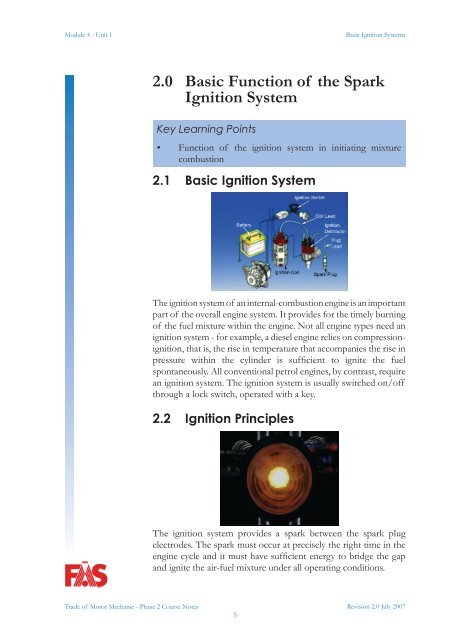Trade of Motor Mechanic - eCollege
Trade of Motor Mechanic - eCollege
Trade of Motor Mechanic - eCollege
Create successful ePaper yourself
Turn your PDF publications into a flip-book with our unique Google optimized e-Paper software.
Module 4 - Unit 1 Basic Ignition Systems<br />
<strong>Trade</strong> <strong>of</strong> <strong>Motor</strong> <strong>Mechanic</strong> - Phase 2 Course Notes<br />
2.0 Basic Function <strong>of</strong> the Spark<br />
Ignition System<br />
Key Learning Points<br />
•<br />
Function <strong>of</strong> the ignition system in initiating mixture<br />
combustion<br />
2.1 Basic Ignition System<br />
The ignition system <strong>of</strong> an internal-combustion engine is an important<br />
part <strong>of</strong> the overall engine system. It provides for the timely burning<br />
<strong>of</strong> the fuel mixture within the engine. Not all engine types need an<br />
ignition system - for example, a diesel engine relies on compressionignition,<br />
that is, the rise in temperature that accompanies the rise in<br />
pressure within the cylinder is sufficient to ignite the fuel<br />
spontaneously. All conventional petrol engines, by contrast, require<br />
an ignition system. The ignition system is usually switched on/<strong>of</strong>f<br />
through a lock switch, operated with a key.<br />
2.2 Ignition Principles<br />
The ignition system provides a spark between the spark plug<br />
electrodes. The spark must occur at precisely the right time in the<br />
engine cycle and it must have sufficient energy to bridge the gap<br />
and ignite the air-fuel mixture under all operating conditions.<br />
5<br />
Revision 2.0 July 2007
















